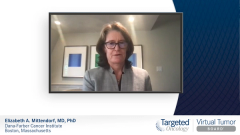
Case 1: IMpassion 130 Trial Design and Results
Experts in breast cancer discuss efficacy data from the IMpassion130 clinical trial.
Episodes in this series

Elizabeth A. Mittendorf, MD, PhD: Before I ask you about your specific recommendations for this patient, I think we have some slides we can present. The first slide is detailing the IMpassion130 study. We all recall, of course, that this was a phase 3 trial that enrolled a little over 900 patients with metastatic triple-negative breast cancer who were PD-L1 positive and were randomized to get either nab-paclitaxel plus atezolizumab or nab-paclitaxel plus placebo. What we found in that trial is that there was an improvement in the progression-free survival, as well as the overall survival for the patients. As an example, the progression-free survival benefit was significant, but it didn’t reach a certain criteria. Therefore, it did not allow us to do a formal statistical comparison of the overall survival. But I think you guys may remember when it was first reported and it looked like there could be a 10-month improvement in overall survival for metastatic triple-negative breast cancer, there were a lot of folks who weren’t looking at that P value. They were looking at the delta the patients were experiencing in survival. That data is shown on the second slide that we have here. That second slide shows that, in fact, the benefit was in patients who had PD-L1–positive tumors.
To clarify, the trial enrolled all-comers, but the benefit was in PD-L1–positive patients, which gets to why David is suggesting that we’re going to look at PD-L1 positivity. If you go to the third slide we have related to this case, it’s looking at the different IHC [immunohistochemistry] assays. Again, what David was referring to, I’ll quickly summarize and ask him to comment. The IMpassion130 trial, which I just discussed, looked at atezolizumab, and the way they define PD-L1 positivity is looking at the immune cells [ICs] that are positive, the IC score, and they used the SP142 assay. In a minute, we’ll get to the KEYNOTE-355 study. That’s a similar trial that looked at pembrolizumab, and as David suggested, they actually use a different antibody, the 22C3, to look at PD-L1 expression, and it looks at it a little differently. It looks at a combination of PD-L1 staining on the immune cells and the tumor cells. David, any thoughts on the concordance that we’ve seen between those assays? The slide depicts some of the data that have been presented.
David G. Hicks, MD: Sure. The interpretation is completely different. For SP142, it’s looking at expression only in immune cells, and it has to be greater than 1% of the area of tumor. For 22C3, it’s the combined proportion score, looking for immune cell staining and tumor cell staining that’s greater than 10% of the area. People have gone back and looked at the concordance; we’ve done that here because now we have both antibodies. SP142, as you mentioned earlier, has seen about 41% of patients [with PD-L1 positivity] in the IMpassion clinical trial, and that’s been our experience here. 22C3 is much higher; it’s close to 80%. What we noticed and what was seen in the IMpassion trial was that the vast majority of patients who were SP142 positive were also 22C3 positive. Close to 30% of patients were positive for 22C3 and negative for SP142. In the IMpassion trial, when you looked at the outcome based on the antibody staining, it really was the SP142 that predicted benefit. If you were positive for 22C3 and negative for SP142, there was no difference. I think the companion diagnostic really needs to be linked with which therapy you’re going to use.
Elizabeth A. Mittendorf, MD, PhD: That’s a really important point. To be honest with you, I feel as if we, as a breast cancer community, are not all aligned with how we’re doing PD-L1 testing. It is good that folks such as yourself are trying to help us answer that question by looking at that concordance.
Transcript edited for clarity.












































